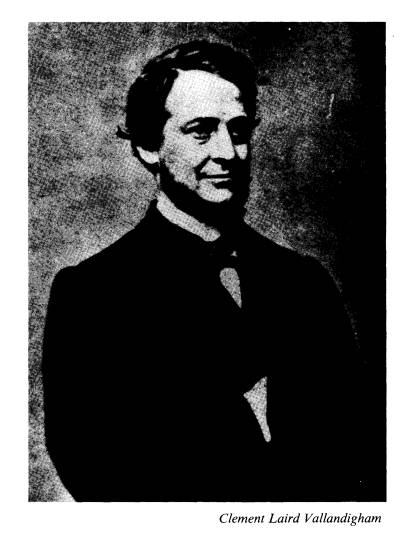Ohio History Journal
edited by
ARNOLD SHANKMAN
Vallandigham's Arrest and
the
1863 Dayton Riot--Two Letters
A noteworthy political event of 1863 was
the arrest and subsequent exile of
Clement Laird Vallandigham. A former
Democratic United States Representative
from Dayton and one of the most eloquent
speakers in the North, Vallandigham
was Ohio's leading Peace Democrat. He
sincerely believed that the Confederacy
could not be subdued by force, and,
although he never advocated permanent sep-
aration of the North and South, his
speeches were so critical of Lincoln and the
President's conduct of the Civil War
that he became a traitor in Unionist eyes.
Early 1863 was a time of mounting peace
sentiment in Ohio. In the spring
there were several instances of draft
resistance, and both Copperhead and Unionist
newspaper editors often found their
offices ransacked by opponents. Vallandigham
capitalized on the growing tensions and
spoke frequently denouncing military rule
and the curtailment of civil liberties.1
To Vallandigham, the loss of civil
liberties was one of the worst aspects of the
war. In the spring of 1863 he selected
as his special target of attack General Am-
brose E. Burnside who had challenged his
point of view. Not long after the Gen-
eral had established his headquarters in
Cincinnati on March 16, he learned of
apparent dangerous Copperhead activities
in his district. In an effort to counteract
what he considered to be treason, the
military commander issued General Order
No. 38, which stated that spies and
traitors would be arrested, brought to trial,
and if convicted, sentenced to death.
The order further announced that the "habit
of declaring sympathies for the
enemy" would not be permitted; individuals con-
victed of this offence would be
imprisoned or exiled to the South. Treason, added
the General, "expressed or implied,
will not be tolerated."2
Carl Sandburg has suggested that the
harshness of the language of the order
was due to Burnside's "chronic
diarrhea," and Ophia Smith has speculated that
Burnside issued the order not only to
trap Vallandigham but also to facilitate the
arrest; of Lottie Moon Clark, a
Confederate spy operating in Ohio, who had jilted
the General at the altar several years
before. Perhaps more plausible than either
1. Eugene H. Roseboom, The Civil War
Era, 1850-1873 (Carl Wittke, ed., The History of the State
of Ohio, Columbus, 1944), IV, 402, 404-408, 411-413.
2. The War of the Rebellion: A
Compilation of the Official Records of the Union and Confederate
Armies (Washington, 1899), Series 2, V, 480.
Mr. Shankman is a doctoral candidate at
Emory University.
